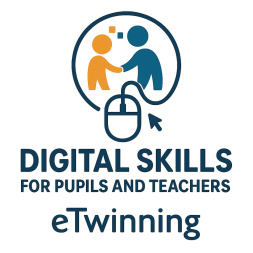July
📡 AI Against Fake News
Project Description:
In this project, students from different countries become digital detectives 🕵️♂️ working together to understand, identify, and fight misinformation online. With the support of AI tools 🤖, they analyze examples of fake news, explore techniques used to manipulate information, and create their own awareness campaigns. The project helps students become more critical, digitally literate, and responsible citizens in the information age.
🎯 Target Group:
- Students aged 12–15
- Project conducted in English
- 3–6 partner schools, with 10–15 students from each school
🗂️ Project Stages:
- Let’s Get Started: Media & Me (1 week)
Students introduce themselves and share examples of media they follow and trust. They reflect on how they consume information and what influences their opinions. - What Is Fake News? (1 week)
Through games, quizzes, and examples, students learn to recognize fake news, deepfakes, and clickbait. - AI on the Case (2 weeks)
Using tools like ChatGPT, Bing Copilot, Gemini, and DALL·E, students analyze suspicious content and check facts. They explore how AI can support or even generate misinformation. - Debunking Challenge (2 weeks)
International teams receive a series of news items — some real, some fake — and work together to verify them. They document their process and share tips for spotting disinformation. - Let’s Create: Digital Citizen’s Code (1 week)
Students co-create a guide to responsible media use and online behavior. - Final Campaign: “Stop the Fake!” (1–2 weeks)
Students design posters, infographics, videos, or memes using AI tools to raise awareness in their schools and online communities. - Reflection and Feedback (1 week)
Students evaluate the role of AI in detecting fake news and reflect on their learning and collaboration experience.
🎯 Project Objectives:
- Developing media literacy and critical thinking 🧠
- Learning how to responsibly use AI tools 🤖
- Improving English language and communication skills 💬
- Encouraging teamwork, international collaboration, and digital citizenship 🌐
📌 Final Outcome:
🎥 An international campaign “Stop the Fake!” featuring AI-generated posters, short videos, and student tips on identifying fake news.
📚 A collaborative e-book: “How to Outsmart Fake News – A Guide by Teens”
🗺️ An interactive map of misinformation examples from different countries
🌿 AI and Nature – Our Green Future
Project Description:
This project combines environmental education with the power of artificial intelligence 🤖 to help students better understand the challenges facing our planet and explore creative, tech-supported ways to protect it.
Through international teamwork, students will use AI tools to create posters, eco-inventions, infographics, and awareness campaigns on topics like climate change, biodiversity, sustainable living, and pollution. The goal is to inspire young people to become environmentally conscious, digitally skilled, and globally connected.
🎯 Target Group:
- Students aged 11–14
- Project conducted in English
- 3–6 partner schools, with 10–15 students from each school
🗂️ Project Stages:
- Let’s Meet in Nature (1 week)
Students introduce themselves and share photos/videos of nature in their regions 🌳. They reflect on local environmental issues and favorite natural places. - Green Topics, Global Concerns (1 week)
Each team selects a theme such as deforestation, endangered species, plastic waste, air quality, or water conservation. - AI in Action: Research & Creation (2–3 weeks)
Using AI tools like ChatGPT, Copilot, DALL·E or Canva AI, students:
📝 write eco-articles, interviews or short stories
🎨 generate images, posters or eco-campaign logos
🧠 brainstorm "green inventions of the future" and create illustrated presentations - The Eco-Innovation Lab (1 week)
International teams present their ideas for AI-powered or tech-supported environmental solutions (e.g. a robot that collects trash, an app that monitors water use). - Online Eco Gallery (1 week)
All creations are published online using tools like Genially, Padlet, or Wakelet. Students can comment, ask questions, and vote for their favorite ideas. - Evaluation & Reflection (1 week)
Students evaluate what they’ve learned about AI and the environment, and reflect on how they can make a difference in their everyday lives 🌱.
🎯 Project Objectives:
- Raising environmental awareness and responsibility 🌍
- Promoting the creative and ethical use of AI tools 🤖
- Improving digital, language, and collaboration skills 🌐
- Encouraging student agency, innovation, and action for sustainability
📌 Final Outcome:
📚 A virtual “Green Future Gallery” with AI-enhanced environmental projects, accessible to students, teachers, and local communities
📘 A collaborative e-book with eco-stories, green tech ideas, and student-made visuals
📣 A digital campaign encouraging peers to take small steps for a greener world




